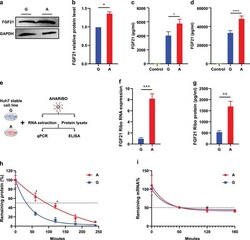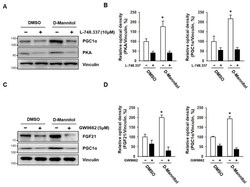Antibody data
- Antibody Data
- Antigen structure
- References [2]
- Comments [0]
- Validations
- Other assay [2]
Submit
Validation data
Reference
Comment
Report error
- Product number
- MA5-32652 - Provider product page

- Provider
- Invitrogen Antibodies
- Product name
- FGF21 Recombinant Rabbit Monoclonal Antibody (JA10-97)
- Antibody type
- Monoclonal
- Antigen
- Synthetic peptide
- Description
- Recombinant rabbit monoclonal antibodies are produced using in vitro expression systems. The expression systems are developed by cloning in the specific antibody DNA sequences from immunoreactive rabbits. Then, individual clones are screened to select the best candidates for production. The advantages of using recombinant rabbit monoclonal antibodies include: better specificity and sensitivity, lot-to-lot consistency, animal origin-free formulations, and broader immunoreactivity to diverse targets due to larger rabbit immune repertoire.
- Reactivity
- Human, Mouse, Rat
- Host
- Rabbit
- Isotype
- IgG
- Antibody clone number
- JA10-97
- Vial size
- 100 µL
- Concentration
- 1 mg/mL
- Storage
- Store at 4°C short term. For long term storage, store at -20°C, avoiding freeze/thaw cycles.
Submitted references D-Mannitol Induces a Brown Fat-like Phenotype via a β3-Adrenergic Receptor-Dependent Mechanism.
Mistranslation Drives Alterations in Protein Levels and the Effects of a Synonymous Variant at the Fibroblast Growth Factor 21 Locus.
Jeon HJ, Choi DK, Choi J, Lee S, Lee H, Yu JH, Min SH
Cells 2021 Mar 31;10(4)
Cells 2021 Mar 31;10(4)
Mistranslation Drives Alterations in Protein Levels and the Effects of a Synonymous Variant at the Fibroblast Growth Factor 21 Locus.
Bayoumi A, Elsayed A, Han S, Petta S, Adams LA, Aller R, Khan A, García-Monzón C, Arias-Loste MT, Miele L, Latchoumanin O, Alenizi S, Gallego-Durán R, Fischer J, Berg T, Craxì A, Metwally M, Qiao L, Liddle C, Yki-Järvinen H, Bugianesi E, Romero-Gomez M, George J, Eslam M
Advanced science (Weinheim, Baden-Wurttemberg, Germany) 2021 Jun;8(11):2004168
Advanced science (Weinheim, Baden-Wurttemberg, Germany) 2021 Jun;8(11):2004168
No comments: Submit comment
Supportive validation
- Submitted by
- Invitrogen Antibodies (provider)
- Main image

- Experimental details
- Figure 2 rs838133 minor (A) allele increases FGF21 protein expression via increasing translation efficiency and reducing protein degradation. Huh7 cells stably expressing either the A or G alleles of rs838133 of FGF21 were analyzed. a) Western blot analysis of FGF21 and GAPDH. b) Graph represents quantification of Western blots with fold change compared to the (G) allele. FGF21 protein level measured by ELISA in c) cell lysate and d) secreted FGF21 in medium. e) Illustration of the experimental workflow to study translational efficiency. f) qRT-PCR of FGF21 mRNA normalized to GAPDH in the ribosomal fraction in the A and G alleles. g) ELISA analysis of FGF21 association with active ribosomes in the A and G alleles. Cells were transiently transfected with the G or A allele during the cycloheximide-chase assay. h) Results of one-phase decay after treatment with cycloheximide (CHX, 100 ug mL -1 ) for FGF21 in the A and G allele; half-life determinations are shown from three independent transfections (A allele, 129.7 min, G allele, 31.48 min). i)Huh7 cells stably expressing the A and G alleles of rs838133 of FGF21 were analyzed for stability of FGF21 mRNA. Cells were treated with actinomycin D to arrest new transcription and is presented as mRNA remaining over time relative to that at 0 h set as 100%. Half-life (50% mRNA remaining [dashed line]): A allele, 30.52 min; G allele, 27.46 min. Values of three independent replicates are represented by vertical bars and are mean +- SEM; *
- Submitted by
- Invitrogen Antibodies (provider)
- Main image

- Experimental details
- Figure 5 D-mannitol induced the generation of a brown fat-like phenotype in adipocytes via a beta3-adrenergic receptor (beta3-AR)- and PPARgamma-dependent mechanism. The adipocytes were treated with L-748.337 (beta3-AR antagonist; 10 muM) ( A ) and GW9662 (PPARgamma antagonist) (5 muM) ( C ), and protein expression levels were determined via Western blotting. The relative optical density was calculated using ImageJ ( B , D ). The significance of protein expression in DMSO- and D-mannitol-treated groups is shown; * = p < 0.05.
 Explore
Explore Validate
Validate Learn
Learn Western blot
Western blot Other assay
Other assay